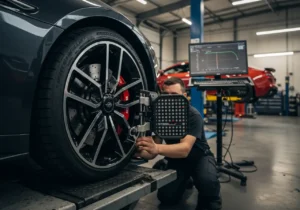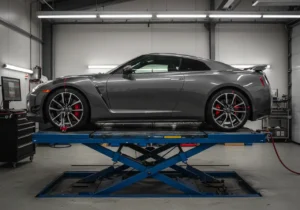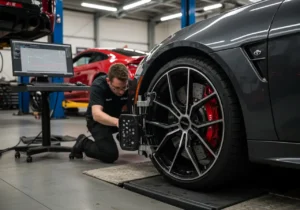The Science Behind Wheel Alignment for Performance Driving
In performance driving, wheel alignment is extremely important. It involves adjusting the angles of the wheels so they are parallel to each other and perpendicular to the road. This isn’t just about making sure your vehicle goes straight; it’s also about improving handling, stability, and tire lifespan.
Misaligned wheels can cause uneven tire wear, reduced grip, and a higher chance of losing control at high speeds. By keeping your wheel alignment accurate, you make sure your vehicle performs optimally, resulting in a safer and more thrilling driving experience.
 Understanding the Three Critical Angles in Wheel Alignment
Understanding the Three Critical Angles in Wheel Alignment
1. Camber Angle
Definition and Measurement Camber angle refers to the tilt of the wheels when viewed from the front of the vehicle. It is measured in degrees, indicating how much the top of the wheel tilts inward (negative camber) or outward (positive camber) relative to a perfectly vertical alignment.
Effects on Tire Contact Patch
- Positive Camber: When wheels have a positive camber, the top of the tires tilt outward. This setting can improve straight-line stability but often reduces cornering performance because it decreases the tire’s contact patch during turns.
- Negative Camber: Negative camber means that the top of the wheels tilts inward. This angle increases the contact patch during cornering maneuvers, enhancing grip and stability. However, excessive negative camber can lead to uneven tire wear, particularly on the inner edges.
Optimal Camber Settings for Different Driving Scenarios
- For everyday driving, a slight negative camber (around -0.5 to -1 degree) is usually optimal as it balances tire wear with handling performance.
- In performance driving or racing scenarios, more aggressive negative camber settings (ranging from -1.5 to -3 degrees) are often used to maximize traction during high-speed cornering.
- During off-road driving, positive camber might be preferred for better vehicle control over rough terrain.
Proper adjustment of camber angle is essential for achieving desired handling characteristics and ensuring even tire wear across different driving conditions.
2. Caster Angle
Caster angle is the forward or rearward tilt of the steering axis, viewed from the side of the vehicle. This angle is measured in degrees and directly impacts both the stability and steering characteristics of a car. While camber and toe angles influence tire contact and wear, caster primarily shapes how your car feels at speed and during directional changes.
Key aspects of caster angle:
- Positive Caster: The top of the steering axis tilts toward the rear of the vehicle. Most performance cars use positive caster because it enhances straight-line stability and improves the self-centering action of the steering wheel. Higher positive caster delivers a firmer, more connected feel at high speeds, making it easier to hold a steady line on straights.
- Negative Caster: The top of the steering axis tilts toward the front. Negative caster settings are rare in modern vehicles due to their tendency to reduce stability and cause vague, less responsive steering.
The science behind wheel alignment for performance driving highlights that caster angle is crucial for:
- Keeping wheels aligned with minimal driver input during aggressive acceleration or high-speed driving.
- Providing predictable feedback when transitioning rapidly between corners.
- Enhancing cornering grip by increasing camber gain on the outside tire as you steer into a turn, working alongside camber angle and toe angle adjustments for optimal performance.
Properly set caster angles are especially valuable for drivers who demand precise control and unwavering stability at speed. Manufacturers specify recommended caster settings for each model; exceeding those values can improve track performance but may come at the cost of increased steering effort during low-speed maneuvers.
3. Toe Angle
The toe angle refers to the direction in which the tires point relative to each other when viewed from above. This angle is vital in maintaining proper wheel alignment throughout the suspension travel range and ensuring stability during driving.
Importance of Toe Angle:
- The toe angle significantly impacts how a vehicle handles and responds to steering inputs. It ensures that wheels remain parallel, minimizing rolling resistance and providing consistent contact with the road surface.
- Proper toe alignment helps to maintain tire longevity by distributing wear evenly across the tire tread. Misalignment can lead to uneven tire wear, reducing overall performance and safety.
Consequences of Excessive Toe-In or Toe-Out:
- Excessive Toe-In: When the front of the tires points inward, it can cause increased tire wear on the outer edges. This misalignment often leads to a “scrubbing” effect, where tires drag against each other, generating heat and accelerating wear.
- Excessive Toe-Out: When the front of the tires points outward, it can result in excessive wear on the inner edges of the tires. This condition compromises vehicle stability and handling, particularly during cornering maneuvers.
Both excessive toe-in and toe-out settings can adversely affect tire wear patterns and compromise vehicle dynamics, highlighting the importance of regular alignment checks. Proper adjustment of camber angle, caster angle, and toe angle ensures optimal performance in driving conditions.
 Benefits of Proper Wheel Alignment for Performance Driving
Benefits of Proper Wheel Alignment for Performance Driving
Precise wheel alignment transforms the dynamics of any performance vehicle. The benefits extend far beyond tire longevity, directly impacting how a car responds and feels on the road or track.
1. Enhanced Handling Responsiveness
When wheels are aligned to exacting standards, steering inputs translate into immediate, predictable movement. You experience sharper turn-in, consistent mid-corner grip, and a direct connection to the road. This heightened feedback is critical during high-speed maneuvers and rapid direction changes.
2. Optimal Stability Under Load
Aggressive driving—hard cornering or heavy braking—demands superior control. Correct alignment ensures that all tires maintain maximum tire-road contact, distributing forces evenly and reducing the risk of unwanted sliding. The result is confidence-inspiring stability at the limits of adhesion.
3. Reduced Rolling Resistance for Better Fuel Efficiency
Misaligned wheels create unnecessary drag, forcing the engine to work harder to overcome resistance. With proper alignment, rolling resistance decreases markedly. This not only preserves tire life but also delivers real-world gains in fuel efficiency—a benefit seldom associated with performance driving but valuable on both street and circuit.
Aligning your suspension geometry isn’t just about keeping tires straight—it’s about unlocking every ounce of performance your chassis has to offer.
The right setup keeps you connected, composed, and competitive each time you push your car’s capabilities.
Consequences of Misaligned Wheels in Performance Driving Scenarios
Misaligned wheels can significantly impact the performance and safety of your vehicle, leading to various issues:
Accelerated Tire Wear Rates
When wheels are not properly aligned, tires wear unevenly. This uneven tire wear reduces the effective contact patch with the road, compromising grip levels over time. As a result, your tires may need replacement more frequently, increasing maintenance costs.
Reduced Stability
Misalignment affects vehicle dynamics, making it more challenging to maintain control during high-speed cornering. This instability is particularly dangerous in performance driving scenarios where precise handling is crucial.
Suspension Strain
Incorrect wheel alignment places additional stress on suspension components such as shocks and struts. Over time, this strain can lead to premature wear and failure of these parts, further compromising vehicle performance and safety.
The science behind wheel alignment for performance driving underscores the importance of maintaining proper wheel geometry. Ensuring that camber, caster, and toe angles are correctly set helps prevent these detrimental effects and keeps your vehicle performing at its best.
 The Importance of Professional Wheel Alignment Services in Performance Driving Maintenance
The Importance of Professional Wheel Alignment Services in Performance Driving Maintenance
Professional wheel alignment services are essential for keeping your vehicle performing at its best and extending its lifespan. These services use state-of-the-art equipment to make precise adjustments to the wheel angles, which is critical for high-performance driving.
How Advanced Tools Make a Difference
- Laser Alignment Systems: These systems use laser technology to measure the alignment angles with high accuracy. The data collected helps technicians make precise adjustments to the camber, caster, and toe angles.
- Computerized Systems: Modern alignment machines often come with automated systems that provide real-time measurements and adjustments. This technology ensures that each wheel is aligned according to exact specifications.
Why Following Manufacturer Specifications Matters
When setting up the wheel angles on a performance vehicle, it’s crucial to follow the manufacturer’s guidelines.
- Optimal Performance: Manufacturer guidelines are designed to optimize the handling characteristics of your specific vehicle model. Following these specifications ensures you achieve the intended performance levels.
- Safety and Stability: Proper adherence minimizes risks associated with misalignment, such as uneven tire wear and compromised vehicle stability.
- Extended Component Life: Correct alignment reduces unnecessary strain on suspension components, extending their lifespan and maintaining overall vehicle health.
By regularly getting your vehicle’s alignment checked by professionals, you can ensure it stays in top shape, ready for thrilling and safe driving experiences.
Conclusion
Proper wheel alignment is not just a technical detail—it’s a fundamental element in achieving peak performance and safety behind the wheel. The science behind wheel alignment for performance driving highlights how precise adjustments of camber, caster, and toe angles deliver tangible improvements in handling, stability, tire longevity, and overall control.
Safety benefits from regular alignments include:
- Consistent tire-road contact for improved grip
- Reduced risk of unpredictable vehicle behavior at high speeds
- Longer-lasting tires and optimized fuel efficiency
You deserve a driving experience that’s both thrilling and secure. Prioritize regular wheel alignment checks as part of your maintenance routine. Schedule professional inspections at recommended intervals or after any significant impact. This commitment not only protects your investment in high-performance equipment but also ensures every drive feels responsive, controlled, and safe—no matter the road ahead.

 Understanding the Three Critical Angles in Wheel Alignment
Understanding the Three Critical Angles in Wheel Alignment Benefits of Proper Wheel Alignment for Performance Driving
Benefits of Proper Wheel Alignment for Performance Driving The Importance of Professional Wheel Alignment Services in Performance Driving Maintenance
The Importance of Professional Wheel Alignment Services in Performance Driving Maintenance